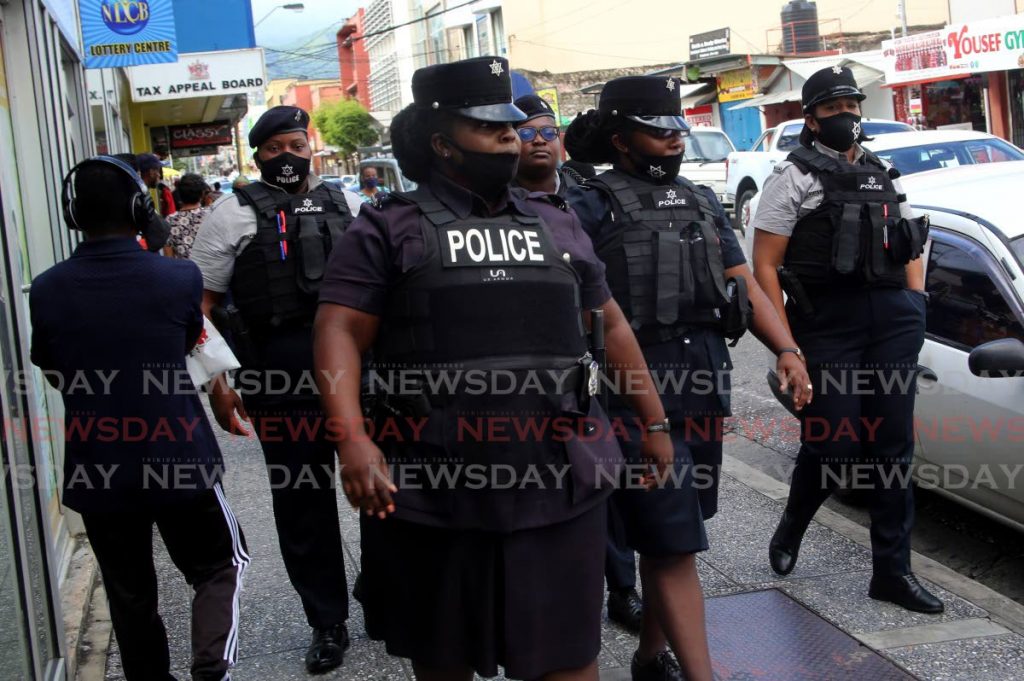Women celebrate 65 years in the police service

FOR 65 YEARS, women have been a leading and driving force behind the police, performing for protecting and serving TT with pride, professionalism and excellence.
Since 1955, there have been over 2,900 women in the police service in every division. Today, there are over 1,800 women working in all divisions.
One such leader was retired Sen Supt June Young-Kendall, who was the first woman police officer to carry the mace at the Independence Day Parade and lead the police in the proceedings.
In a phone conversation with Newsday Young-Kendall said she joined the service in 1961 at the age of 18 and would go on to spend more than 41 years in the TTPS. While in the police band, she played drums. But in the early 70’s, a couple years after the Black Power Riots, she was placed at the front of the music band to carry the parade mace and lead the music band, which would in turn lead the police for the parade. She said she led the parade in Couva, and Arima, and said although she wished she would have led in Port of Spain and marched down Frederick Street, it was still an experience she would not forget.
“Leading the parade as a woman was an achievement, but throwing the mace was not an easy thing,” she said. “You couldn’t think about all the people looking at you or how you were feeling. You had to focus on holding the mace and catching it when it goes up in the air.”
Since then, she, like several other women have taken positions to lead the police to becoming what it is today with women leading some of the its most elite services.
But it wasn’t always that way.
Although women were allowed in the police since the mid-50s, it wasn’t until the 80’s that that women were truly treated equally. Up until that time, women were mostly brought into the service to treat with women’s issues, juveniles and the elderly.
“When we were training we were put last on the parade (meaning they had the lowest rank) No matter what marks you made in the exams we were put last; we were even placed after the drivers. That was the kind of gender situation that we dealt with,” said retired ACP Margaret Sampson-Browne who joined the police in 1970.

Sampson-Browne said promotion also took a long time for women. She said some women would retire from the service before they could have gotten promotion. Women, prior to the 80’s were treated as a separate division as the male police service. But Sampson-Browne said although they were not promoted immediately, the first batches of women in the TTPS were specialists in dealing with people.
“The orders we were given was to find ourselves in the street where women and children were. We would deal with the women prisoners and sometimes we would even take the key to the prison home. On Saturdays we had juvenile warnings where we would have to escort juveniles who were behaving badly to a judge who would give him or her formal warning in front their parents. We would also have to visit schools and get lists of all the students who were habitually late, or who missed school and we would have to follow up on them, and find out why they were missing school or coming late.”
Beside these duties they would also have to go on normal police patrols to assist should there be a female among those arrested in raids and also go undercover.
“I remember posing as a patron in a party to catch a thief, and pretending to be a yogurt vendor,” Sampson-Browne said “We would do these duties, and still we would have to be a wife and a mother.”
But as women were allowed to progress they took every advantage available. One such woman was retired Ag ACP of the Northern Division Amber Denoon, who graduated in the same batch as Sampson-Browne in 1970. She described her highly fulfilling carreer to Newsday, saying the job of someone in the police was the equivalent to several jobs in one.
“I don’t think I knew a single police officer growing up,” she said. “I just wanted to do something different. I was 18 going on 19, and I was repeating my “O” Levels, and police were recruiting because of the Black Power Movement. I remember going in my school uniform to apply.”
Denoon said she took part in every aspect of the service available, from horseback riding to project management. In her project management role, she said she was involved with the building of several police stations including the Sangre Grande, Maraval and Four Roads stations.
“Every week we would be on site with hard hats. We would look at finances for the projects as well. Essentially, I would represent the Commissioner of Police with these projects. I also went into court prosecution. It was great. You would grow from dealing with traffic offences until you start presenting evidence for murders. I also worked in the juvenile bureau where I worked with women and children and changed lives. There were so many jobs in this one career. We would take everything we learned and put it into policing.”
The retired policewomen expressed pride in the female police officers of today. They also make up the executive who make key decisions on the progress of the service.
In a video, ACP in charge of administration Beverly Lewis said the TTPS benefited tremendously from the service of women police officers who continue to perform.
“Today as we celebrate I urge all women police officers to continue to find innovative solutions to the issues we face as both an organisation and a society,” she said.


Comments
"Women celebrate 65 years in the police service"